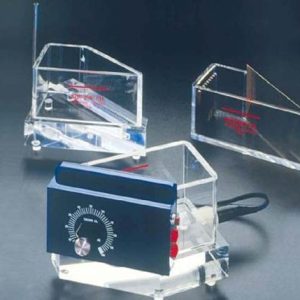Hull Cell Anodes – They come in many types. Where possible you should use anodes that are metallurgically as close to as possible to those used in production. Here is a listing of the more common types, and where appropriate, particular applications:
- Aluminum. For evaluating electropolishing, they are ideally cut from the same stock as that being processed.
Brass or bronze. Use the same alloy used in production. Bag the brass or bronze anode when appropriate. You do not need a professional seamstress; just a loose cloth bag for the anode. - Cadmium. Can be used for acid, cyanide, and “neutral” systems. Where anodes are bagged in production, the Hull cell anode also should be bagged.
- Copper. Oxygen Free High Conductivity (OFHC) copper anodes are generally acceptable; however, for printed-circuit testing, exact duplication of the anode used in production is more critical. Anode bagging should again duplicate that in the process system.
- Lead. More appropriately tin/lead (10% tin) is used in chromium plating, since it provides good efficiency and allows for reoxidizing of hexavalent to trivalent chrome — a vital function in the chromium plating process.
- Nickel. Almost without exception, nickel plating requires single- and often double- bagging of anodes. Whatever is used for the outer bag will normally suffice for Hull-Cell testing.
- Stainless Steel. Be aware that 300 stainless contains some or a lot of chrome. In testing electropolishing, 400 stainless is less likely to introduce a little chromium contaminant. Just a little causes a lot of problems.
- Steel. If an alkaline zinc system is being fed from a zinc generator, a plain steel anode that does not have a bunch of numbers to describe the steel is best. All those numbers designate potential contaminating metals. 1010 works very well.
- Tin. Pure electrolytic tin, and bagged.
- Titanium. Prime application is in electropolishing.
- Zinc. By all means, bag if being used in the tank that way.
Note: In the case of the many new alloys that are electrodeposited, use the same type anode as that used in the process.




